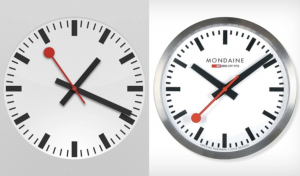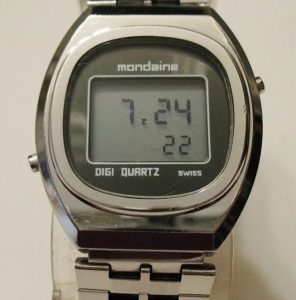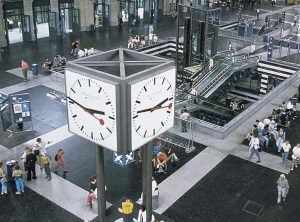Mondaine is known the world over for their iconic watch design inspired by the clocks found in railway stations all over Switzerland and across Europe. But long before introducing the world to their wearable version, Mondaine had already had an interesting history. Our online shop FourteenNinetyTwo.com is a proud authorized dealer for the historic brand.
To celebrate their new watch designs, we are giving away a Mondaine watch – for which the lucky gets to pick any timepiece they chose. Keep reading below for details.

A BRIEF HISTORY OF MONDAINE
Started in 1951 by Erwin Bernheim, the company initially concentrated on exporting various small Swiss watch brands internationally until, in the 1960s, they began manufacturing their own watches. These were known for their high quality vis a vis their relatively low cost of repair and maintenance.
In the 1960s, Bernheim, working with the Howard Hughes’ company Hughes Aircraft, designed one of the first Liquid Crystal Display (LCD) digital watches. This was in the early days of the digital watch and any contemporary models such as the famous Pulsar by Hamilton, were in the LED format. But LED required a lot of battery power, so Mondaine concentrated on LCD technology and produced the first Swiss made digital watch in 1968 spurring a digital format that eventually became the standard still in use today.
By the 1980s Bernheim, now working with his son Ronnie, was determined to develop the “Volkswagen” of Swiss watches; something of quality for everyday wear and reasonably priced – something that was not yet readily available in the Swiss watch industry. In 1983 in partnership with Migros, a Swiss retail giant, Mondaine was able to design and manufacture the first “M watch” from concept to prototype within a month. The “M” line still exists to this day and has expanded to include plastic “Swatch” type models as well as more robust metal dive watches, all battery powered and at competitive prices.

But it was later in the 1980’s that Mondaine would make a move that would redefine its image to the one we think of today – the decision to license the design of the Swiss Railway Clock which had already been famous in Switzerland for over 30 years.

THE SWISS RAILWAY CLOCK
In 1944 Hans Hilfiker, an engineer by training and an employee of Swiss Federal Railways (SBB), created a system whereby all the clocks in the stations did not run independently, but were instead connected through the telephone lines to a master clock in the signal box. This ensured that all railway clocks were accurate and synchronised – something the Swiss take really, really seriously. To go along with the new system, he created a simple, easy to read clockface that was legible from some distance away. This design remained unchanged until the red “lollypop” seconds hand (suggested by the baton wielded by station staff) was added in 1953, completing the iconic design that is still being used today.
Aside from being visually different, this new seconds hand had another feature that made it distinctive. It would move slightly faster than normal and take only 58.5 seconds to make the full 360-degree sweep around the dial. It would then hesitate for 1.5 seconds at the 12 marker, until the minute received the signal from the central clock to move forward to the next minute, at which point, the seconds hand would resume it’s 58.5 second journey once again. All clocks in the system would receive the signal at the same instant, ensuring that they were all in sync.
Ironically, this means all the railway clocks are essentially useless on their own – they rely on the central clock to tell the correct time. The seconds hand moves independently within the clock, while the other hands remain static and without power – until they receive the fleeting electrical signal that moves them to the next minute. The Swiss were justifiably proud of these clocks which were not only accurate, but very distinctive in their Bauhaus-inspired look.

SWISS RAILWAYS WATCH
In 1986, Mondaine licensed the use of the SBB Clock design to create the Official Swiss Railways Watch. In keeping with the idiosyncratic nature of the clock, the watch also featured a seconds hand that hesitated at the 12 to allow the minute hand to “catch up”. This mechanical model was discontinued in 2001, but a similar, redesigned one – the “Stop2Go” – was released to much fanfare in 2012. Powered by a quartz movement that has 2 motors that work independently – one for the hour and minute hands and one for the seconds. The classic look of black indices on white which had become Mondaine’s own marketing image has now expanded to include white on black, blue and grey, as well as gold tone on white, rose gold on black etc., but all of them sporting the iconic red seconds hand. Most of these, while looking like the original, will not have the hesitating seconds hand, but will use a conventional quartz movement or in some cases, an automatic movement.

Although the Stop2Go watch will mimic the action of the rail station clock, to get as close to the real thing as possible you need to get the WIFI enabled Stop2Go Clock. Once connected to your smartphone via WIFI, this wall mounted clock will be as accurate as your phone – and the initial set-up is very sharp as the hands zoom around the dial as the initial synchronisation kicks in.

The SBB Clock is now considered a Swiss national icon and can be seen displayed in the Design Museum in London, the Museum of Modern Art in New York City and has even been commemorated on a Swiss stamp in 2007.
APPLE iOS LAWSUIT
The design proved to be so iconic that when Apple introduced iOS 6 in September of 2012, they “inadvertently” used it as inspiration for the look of the clock on the iPad. SBB, while applauding Apple’s good taste nonetheless pointed out that Apple did not have the rights to use the design. Although normally litigious and with the deep pockets to back it up, Apple must have seen that they didn’t have a leg to stand on and decided rather quickly, in October of 2012, to settle with SBB for a little under $25 million US and decided not to bring it back for iOS 7. It’s unfortunate that Hilfiker (who died in 1993) didn’t live to see one of the most cutting-edge companies, renown for their minimalist design, use one he created nearly 70 years before.
In collaboration with our online shop, FourteenNinetyTwo.com, we invite you to Enter for a chance to win ANY Mondaine watch or Clock of your choice.

MONDAINE CONTEST
Here’s how:
-
We have a new Instagram page – Simply follow us and you will be automatically entered. AND / OR
-
Send an email to: info@FourteenNinetyTwo.com with the subject line: “I WANT A MONDAINE”












